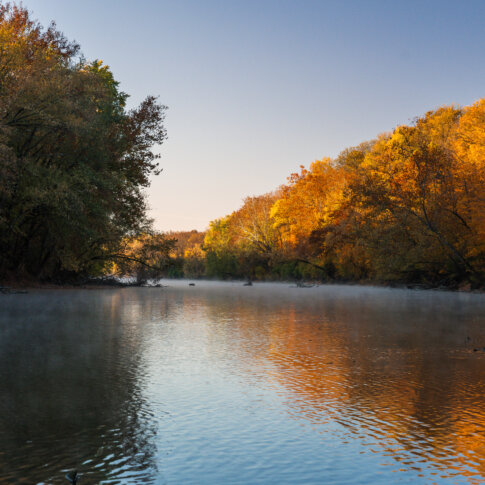
As part of the Invasive Species Awareness Week with the Hamilton County Invasives Partnership (HIP), we’re bringing you a special post to explore how different types of plants affect the health of the river.
What’s so bad about invasive species?
Invasive plants are any plants that are not native to an ecosystem and cause, or are likely to cause, harm to human health, the environment, or the economy. They’re often contrasted with native plants which have evolved together in one region over the ages, functioning as one healthy ecosystem with local insects, birds, and other animals.
Invasive plants pose a significant threat to the White River ecosystem because they:
- Outcompete Native Species: Invasive plants often grow faster and reproduce more prolifically than native species, depriving them of vital resources like sunlight, nutrients, and space.
- Alter Habitats: These invaders can alter riverbank structures, creating dense monocultures that hinder the growth of native vegetation and alter the physical structure of the riverbed.
- Reduce Biodiversity: Invasive species can reduce the variety of native plants and animals by displacing them or providing insufficient food and habitat resources.
The Ripple Effect
Rivers are the lifeblood of our ecosystems, so when our rivers are in trouble, we’re all in trouble. The White River is a critical part of our community. The presence of invasive species and the decline of native plants in river ecosystems can have dangerous consequences in central Indiana:
- Increased Vulnerability to Flooding: Reduced soil stability and altered riverbank structures can make areas more susceptible to erosion and flooding.
- Impaired Water Quality: Invasive species can disrupt nutrient cycling and lead to the accumulation of harmful pollutants in the river, negatively impacting aquatic life and downstream water quality.
- Economic Costs: Managing invasive species and dealing with the consequences of their presence in rivers can be costly for communities and industries that rely on these water bodies.

Local Invasives
Along parts of the White River Asian Bush Honeysuckle grows in thick patches. It kills off native plants by leafing out very early in the spring to block sunlight from plants below and by sending out toxins into the soil to kill other plants.
Winter Creeper also grows on our riverbanks, outcompeting native plants and increasing soil erosion.
In the river itself, you can also find the long, leafy Eurasian Milfoil. It can clog up shallow parts of the river and make it hard to swim or paddle through the long underwater plants.
Native Plants to the Rescue!
In contrast, native plants play a crucial role in maintaining the health and balance of river ecosystems:
- Coevolution: Native plants have evolved alongside native wildlife, forming complex relationships that support the entire food web. For instance, native plants provide food and shelter for insects, which, in turn, are a vital food source for many river-dwelling species.
- Soil Stabilization: Native plants have deep root systems that help prevent soil erosion along riverbanks, maintaining water quality and preventing sedimentation (when the river is polluted with too much dirt).
- Resilience: Native plants are well-suited to the specific environmental conditions of their native river ecosystems, making them more resistant to drought and flooding.
What can you do?
It’s crucial for us to take action to prevent the spread of invasive species in our waterways. Join HIP at one of the Invasive Species Awareness Week activities, or read more about stopping invasives and growing natives in our area.
Let’s restore and protect our precious White River ecosystem together!

Tagged in: Nature, Restoration, Noblesville, Fishers, White RIver, Carmel, Indianapolis, Invasives



